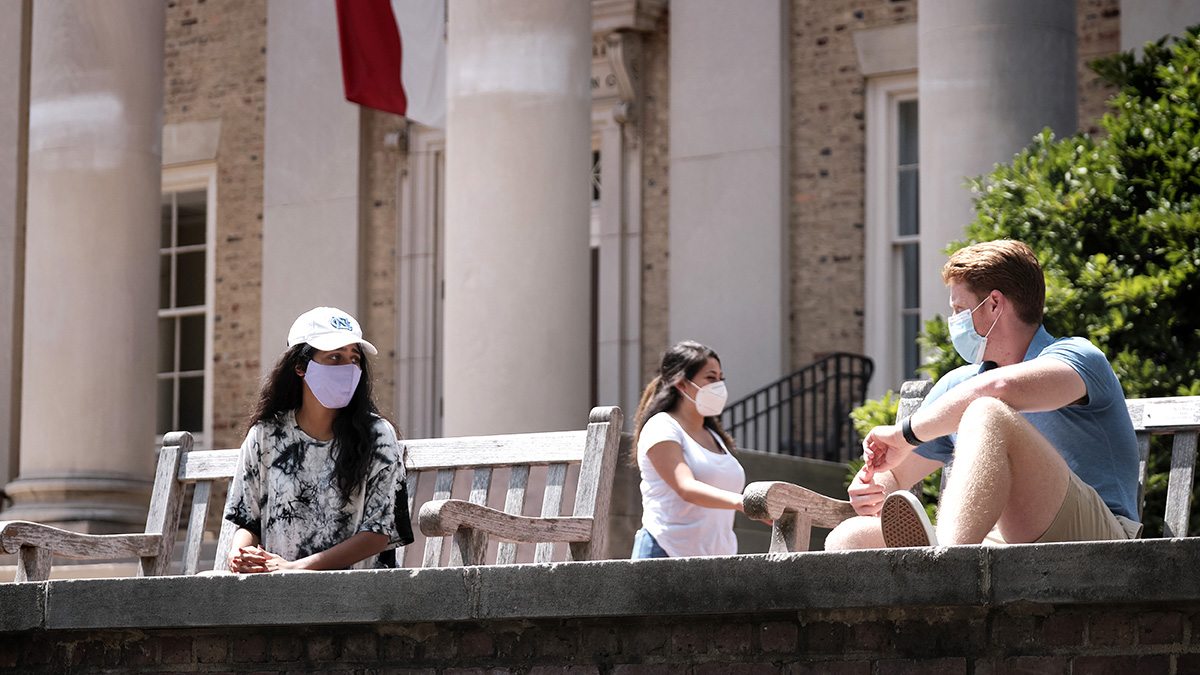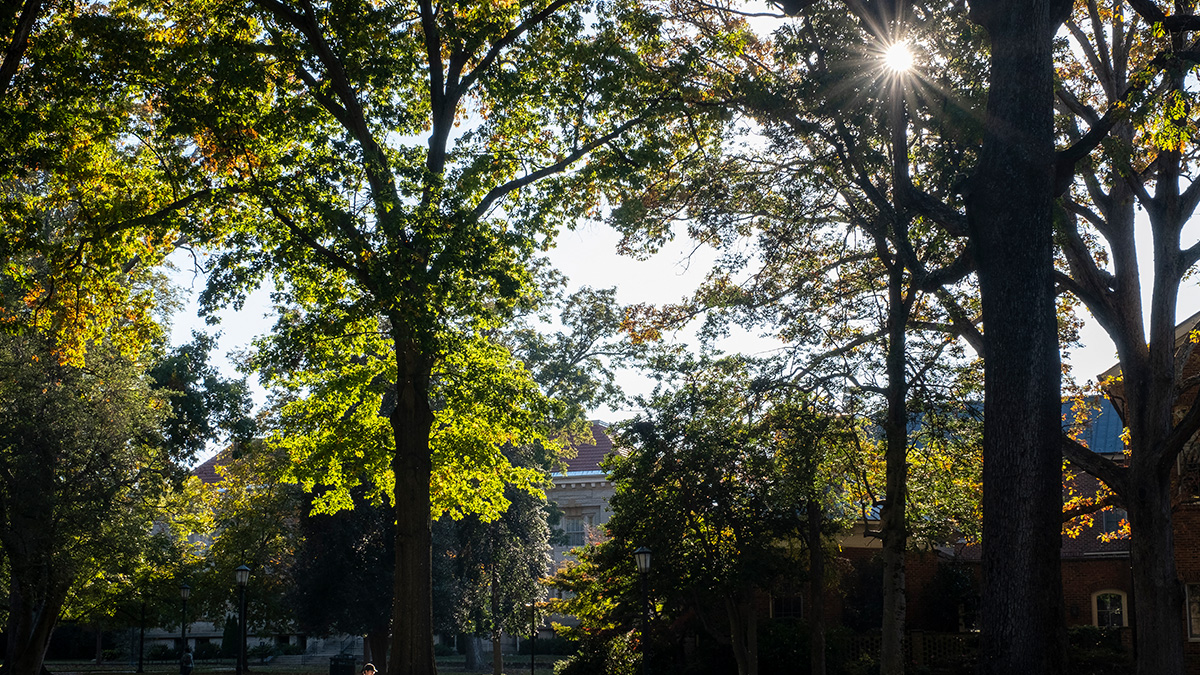Masks, masks and more masks
With new research identifying the nose as the coronavirus’s main entry point, Carolina experts offer tips on best masks, best fit and best practices.

Your nose is prime real estate for the coronavirus.
It’s where the coronavirus infection settles in first before traveling to the lungs, according to new research by Carolina scientists.
That’s why wearing a mask that covers your nose and mouth is the best way to protect yourself and those around you. Yes, you’ve heard plenty about masks. But this new research makes it absolutely clear just how critical masks are for protecting yourself and others from the coronavirus.
The study results, published in the journal Cell by researchers at the UNC Gillings School of Global Public Health and the UNC School of Medicine, indicate that the virus firmly establishes itself inside the nose first. Then, in some cases, people breathe the virus into their lungs where it may lead to more serious disease, including potentially fatal COVID-19 pneumonia.
“If the nose is the dominant initial site from which lung infections are seeded, then the widespread use of masks to protect the nasal passages, as well as any therapeutic strategies that reduce virus in the nose, such as nasal irrigation or antiviral nasal sprays, could be beneficial,” said study co-senior author Dr. Richard Boucher, the James C. Moeser Eminent Distinguished Professor of Medicine and director of the School of Medicine’s Marsico Lung Institute.
The nose and nasal-lining cells may be more susceptible to infection because cell-surface receptor ACE2, the method by which the virus enters cells, is more abundant there than on the surface of lower airway cells. This may explain why people at higher risk for severe lung disease — the elderly, obese and diabetic — are generally more prone to breathing in the virus, especially at night, and then contracting COVID-19 pneumonia.
The other co-senior author of the study was Ralph Baric, the William R. Kenan Distinguished Professor of epidemiology at the UNC Gillings School of Global Public Health. The study’s first authors are Yixuan Hou, Kenichi Okuda, Caitlin Edwards and David Martinez, all from UNC-Chapel Hill.
Who should wear a mask?
The short answer: everybody.
Why? Wearing a mask is the single best thing we all can do to reduce the viral spread, say other Carolina experts in infectious disease, toxicology and microbiology.
In a meeting of the University’s Faculty Executive Committee on June 8, Dr. David Jay Weber, professor of microbiology and medicine, said that some people are presymptomatic (transmitting the virus before having symptoms) and others are asymptomatic (transmitting the virus without any symptoms). “That is why everybody needs to wear a mask, not only to protect themselves but also protect people in the surrounding area,” Weber said.
Dr. Myron “Mike” Cohen, associate vice chancellor for global health and medical affairs, told the committee that, in Asia, masks made “an incredible difference” in reducing transmission and protecting uninfected people. Cohen also stressed in a June 14 broadcast of CBS’s 60 Minutes the importance of “masks, masks and more masks.”
What mask should you wear?
All masks are not created equal, but several offer good protection.
That’s the conclusion of a team at the Mucociliary Clearance and Aerosol Research Laboratory in the UNC Center for Environmental Medicine, Asthma and Lung Biology that tested the effectiveness of different masks in filtering air particles
There’s clearly a difference between N95 respirators worn by health care workers treating COVID-19 cases and masks the general public should wear, said team member Phillip Clapp, who is a research assistant professor in the School of Medicine’s pediatrics department.
Health care workers need N95 respirators because they are at a higher risk for exposure to airborne droplets containing virus, and respirators can filter 95% or more of droplets from the air. However, the general public doesn’t need-high efficiency respirators. Simply wearing a mask or face covering can protect those around you from droplets you produce when coughing, sneezing, singing or talking.
Clapp and his colleagues tested various masks, including N95 respirators, Chinese-made KN-95 respirators, commercially made surgical masks, 3D-printed designs and some homemade cloth masks. Surgical masks with ear loops tested at 30% filtration, but a tighter fit with after-market mask extenders dramatically improved filtration. Surgical masks with tie strings tested at 65% effectiveness.
Clapp recommends following CDC guidelines for using masks and face coverings and urges the do-it-yourself mask-makers to be careful, as some materials have not been evaluated for inhalation toxicity.
Rachel Noble, a public health microbiologist who is a professor in the Gillings School’s department of environmental sciences and engineering, said that cloth for homemade masks has to be tightly woven — “think high thread-count bedsheet, not the material of a sweater or any loose-knit.
“I would definitely say a mask is one of our top ways of protecting ourselves and others in the community from COVID-19 infections. Given the cost of a mask and the general availability of disposable masks and that many styles of masks are easy to make with materials that people have at the house, it makes all the sense in the world,” said Noble, who is also Hill Distinguished Professor in Carolina’s Institute of Marine Sciences.
Masks dramatically reduce infections
Noble said that laboratory-controlled experiments are “very, very clear” on the value of masks. “That’s why people in safety work, in wastewater treatment plants, in medical environments and clinical laboratories have been wearing masks for decades and many cultures have been wearing them for a century or more,” she said.
Data from places with widespread mask use show a dramatic reduction in infections, echoing what many medical professionals such as surgeon and New Yorker magazine staff writer Dr. Atul Gawande have observed.
Clapp said that the research puts a fine point on what wearing a mask does. “You have a personal need and then you have community need. I think right now, if you’re not on the front lines, it’s best to address the community need,” he said.
Tips from Carolina’s experts:
- Cover your nose and mouth with a mask in a tight fit that enables air to pass through the mask in a non-suffocating way, not from the sides.
- Have a mask for each day of the week. After wearing one, place it in a labeled paper bag for use one week later. CDC research shows the virus will not live on such a surface for a week.
- Wash any mask that is dirty, has been handled with dirty hands or been exposed to surfaces. Use detergent, hot water and bleach additive, then hang to dry. Do not wash N95 masks, as that will lessen effectiveness.
- Avoid multiple layers and high-filtering N95 masks, which may impair breathing for people with health concerns such as cardiopulmonary disease.
- Use tie strings or a rubber band that goes at the back of your head to decrease adjustments.
- Decrease adjustments, especially among children, with self-competition to see how long you can go without touching the mask after you’ve got it fitting correctly.
See Carolina’s Together website for more information on masks and community standards. Learn where the towns of Carrboro and Chapel Hill and Orange County are distributing free masks.




